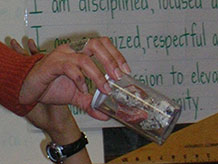What is soil made of?
4. Make meaning
Purpose of the discussion
The purpose of the discussion is to elicit students' ideas about soil now that they've made observation, and to encourage them to support their ideas with evidence from their observations. Return to the investigation question for the discussion.
Engage students in the focus question
Begin by reviewing the class observations. Have students raise any questions or comment on what they noticed in the data.

Return to the investigation question:
What ideas do you have now about what soil is made of? Not just these two soils, but all soils?
Students might suggest that soil is a mixture of different sized pieces of rock. Or that soil contains plant material. Or that soil contains minerals. Ask them to support their claims, citing evidence from their own or class data.
- What is between the bits of mineral and plant material in the soil?
Students may be puzzled by the question. They may say there is "nothing" there; "just air" or "empty space." Affirm that the students are correct, and that the empty places are a very important part of the soil. The empty places hold air and water, which allow plants to grow.
There remains one last question:
- Where do you think the soil grains come from?
Examples of weathering actions: Weathering can happen as water flowing in a river bangs rocks against each another, chipping off pieces. Or as the tide rolls rocks and shells up and down the beach every day. Or as acid rain dissolves some of the minerals in rocks, causing pieces to break off.
Let students brainstorm some ideas, making claims and supporting them as best they can with their data, e.g. “I see little bits of quartz in the soil. I think a big piece got pulverized somehow.” Or, “Soil B smells like the woods. I think there are rotten leaves in this soil.”
Introduce the term "weathering." Explain that weathering is the natural process by which larger formations or pieces of rock and mineral break down into smaller pieces through the actions of water, wind, ice, expanding roots, and other forces. It’s the weathering of rocks and minerals and the decomposition of plants and animals that create new soil grains. Those rocks, minerals, plants, and animals are called the parent materials of the soil.
Students may read the information sheet Weathering found in the back of the student notebook. They might also write about soil and weathering in their notebook [Soil and weathering].
Summarize the discussion and recap the investigation
As you summarize the discussion, reinforce these two big ideas:
- Soils are made up of minerals and organic matter, and include spaces between the soil grains that hold air and water.
- Soils come from parent materials that break down through processes of weathering and decomposition.



